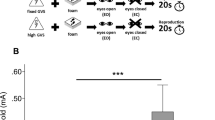Abstract
Single intramuscular doses of scopolamine and matching placebo were administered to young, healthy, and emmetropic volunteers. Electroretinograms and visual evoked potentials (flash and pattern stimuli) were recorded prior to and 30, 90, and 120 min after administration. The effects of scopolamine at the central nervous system level were monitored also by quantitative electroencephalographic methods. Scopolamine reduced the peak-to-peak amplitude of the late components of the flash-evoked potential without affecting latencies. A decrease of the N75 latency and increment of N175 latency of pattern-evoked potentials were observed without any apparent modification of the amplitude values. These changes were not produced by administering topical cyclopentholate. Electroencephalographic effects were apparent with a longer delay after administration than were those on the visual evoked potentials. No significant modification was observed in the electroretinogram under these recording conditions.
Similar content being viewed by others
References
Barber C. Evoked potentials. Lancaster: MTP Press, 1980.
Bartus RT, Dean RL, Beer B, Lippa AS. The cholinergic hypothesis of geriatric memory disfunction. Science 1982; 217: 408–417.
Birdsall NJ, Burgen ASV, Hulme EC. Correlation between the binding properties and pharmacological responses of muscarinic receptors. In: Cholinergic mechanisms and psychopharmacology, Vol. 24, ed. Jenden, D.J. New York: Plenum Press, 1978; 25–33.
Birdsall NJ, Burgen ASV, Hulme EC. Multiple classes of muscarinic receptor binding sites in the brain. In: Receptors, Vol. 1, Advances in pharmacology and therapeutics: proceedings of the seventh international congress of pharmacology, ed. Jacob. Oxford: Pergamon Press, 1979; 73–80.
Bodis-Wollner I, Onofrj M. System diseases and VEP diagnosis in neurology: changes due to synaptic malfunctions. Ann NY Acad. Sci 1982; 388: 327–349.
Brimblecombe RW. Drug actions on cholinergic systems. Baltimore: University Park Press, 1974.
Cant BR, Hume AK, Shaw NA. Effects of luminance on the pattern visual evoked potential in multiple sclerosis. Electroencephalogr. Clin Neurophysiol 1978; 45: 496–504.
Ciganek L. The EEG response (evoked potentials) to light stimulus in man. Electroencephalogr Clin Neurophysiol 1961; 13: 165–172.
Corssen G, Domino, EF. Visually evoked responses in man: a method for measuring cerebral effects of preanesthetic medication. Anesthesiology. 1964; 25: 330–341.
Davis KL, Mohs RC. Enhancement of memory processes in Alzheimer's disease with multiple-dose intravenous physostigmine. Am J Psychiatr 1982; 139: 1421–1424.
Domino EF, Corssen G, Sweet RB. Effects of various general anesthetics on the visually evoked potentials in man. Anesthesiol Analges 1963; 42: 735–747.
Ferris SH, Reisberg B, Crook T, Friedman E, Schneck MK, Mir P, Sherman KA, Corwin J, Gershon S, Bartus RT. Pharmacological treatment of senile dementia: choline, L-DOPA, piracetam and choline plus piracetam. In: Aging, Vol 19, eds. Corkin, Davis, Growdon, Usdin, Wurtman. New York: Raven Press, 1982: 475–481.
Fink M. EEG and human psychopharmacology. Ann Rev Pharmacol 1969; 9: 241–258.
Fink M. EEG and psychopharmacology. In: Contemporary clinical neurophysiology (EEG suppl., 34), eds. Cobb WA, van Dujin H. Amsterdam: Elsevier, 1978; 42–56.
Harden A. A non-corneal electroretinogram. Br J Ophthalmol 1974; 58: 811–816.
Harter MR. Evoked cortical response to checkerboard patterns: effects of check size as a function of retinal eccentricity. Vision Res 1970; 10: 1365–1376.
Herrmann WM, ed. Electroencephalography in drug research. Stuggart: G. Fischer, 1982.
Itil TM, ed. Psychotropic drugs and the human EEG. Basel: Karger, 1974.
Krnjevic K. Chemical nature of synaptic transmission in vertebrates. Physiol Rev 1974; 54: 418–540.
Papakostopoulos D. Clinical electrophysiology of the human visual system. In: Clinical application of cerebral evoked potentials in pediatric medicine, eds. Chiarenza, GA, Papakostopoulos, D. Amsterdam: Excerpta Medica, 1982: 3–40.
Robson JC, Spatial and temporal contrast sensitivity functions of the visual system. J Opt Soc Am 1982; 56: 1141–1142.
Rodin EA, Luby, ED. The effects of some psychotomimetic agents on visually evoked responses and background EEG. Electroencephalogr Clin Neurophysiol 1965: 19: 319.
Sannita WG, Cabri M, Montano V, Rosadini G. Quantitative EEG and behavioral effects in volunteers of a new benzodiazepine (SAS643) in relation to drug plasma concentration. Ther Drug Monk 1981; 3: 341–349.
Sannita WG, Balestra V, Rosadini G, Salama M, Timitilli C. Quantitative EEG and neuropsychological effects of piracetam and of the association piracetam-lecithin in healthy volunteers. Neuropsychobiol. 1985: 14: 203–209.
Shagass C. Pharmacology of evoked potentials in man. In: Psychopharmacology: A review of progress 1957–1967, eds. Efron DH, Cole JO, Levine J, Wittenborn JR Washington, D.C.: Government Printing Office, 1968; 671–682.
Shagass C. Evoked brain potentials in psychiatry. New York: Plenum Press, 1972.
Stockard JJ, Hughes JF, Sharbrough FW. Visually evoked potentials to electronic pattern reversal: latency variations with gender, age, and technical factors. Am J EEG Technol 1979; 19: 171–204.
Tartaglione A, Pizio N, Bino G, Spadavecchia L, Favale E. VEP changes in Parkinson's disease are stimulus specific. J Neurol Neurosurg Psychiatr 1984; 47: 305–307.
Tepas DI, Armington JC. Electroretinogram from noncorneal electrodes. Invest Ophthalmol 1962; 1: 784–786.
Weiner N, Atropine, scopolamine, and related antimuscarinic drugs. In: The pharmacological basis of therapeutics, eds. Goodman Gilman H, Goodman LS, Gilman A. New York: Macmillan, 1980.
Winer BJ, Statistical principles in experimental design. New York: McGraw-Hill, 1971.
Author information
Authors and Affiliations
Rights and permissions
About this article
Cite this article
Sannita, W.G., Fioretto, M., Maggi, L. et al. Effects of scopolamine parenteral administration on the electroretinogram, visual evoked potentials, and quantitative electroencephalogram of healthy volunteers. Doc Ophthalmol 67, 379–388 (1987). https://doi.org/10.1007/BF00143956
Issue Date:
DOI: https://doi.org/10.1007/BF00143956




